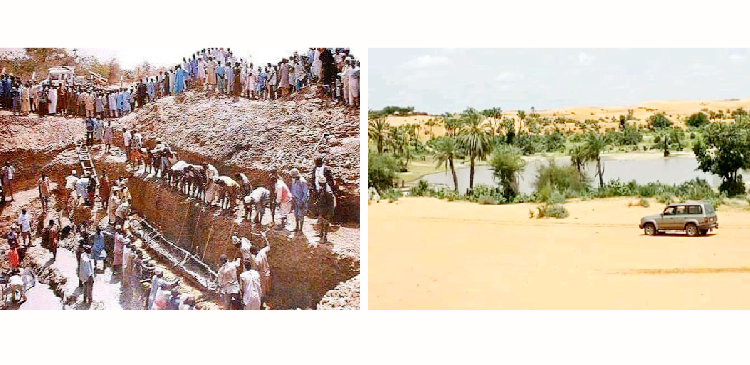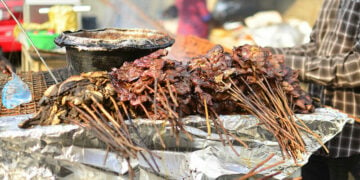Being one of the worldwide leading industries, tourism has been the top three elements of world trade positioned third after petroleum and auto industry. In 2021, the travel and tourism industry contributed 3.6 percent to Nigeria’s Gross Domestic Product (GDP), which was equal to around 16 billion US dollars indicating an increase of travel and tourism to the Nigerian compared to 2020 contributions.
Nigeria Tourism Industry Outlook 2022–2026 Key market indicators showed that Tourism receipts in Nigeria are set to reach $12 billion by 2026 up from $8.6 billion in 2021. The market has grown an average of 1.8% year on year since 2000, with a total increase of 13.7% over that period.
At a time when many countries are struggling on how best they can create tourism attraction spots, in Nigeria, many states were blessed with several untapped tourist destination sites.
In Yobe, there are 15 officially recognised tourism attraction sites and events, many of which were discovered for centuries though they either receive little or no attention by both federal and state governments.
The 15 official tourists attraction sites and events in Yobe State are Dofarga Spring Water, Dogana Birds Sanctuary, Old Gogaram, Birnin Ngazargamu, Tulo-Tulowa Desert, Old Diniski Settlement, Grave yard of emir of Fika, Fika Emirate Museum, Duwa Adura Na Jagari (Twin mouth well), Kadi (Goya) Valley, Gudi Settlement, Duwa Doka (Rijiyan Doka), Gogaram Bade Fishing Festival, Machina Annual Cultural Festival (MACUF) and the 8000 years Dufuna Canoe believed to be the African’s oldest canoe ever discovered.
The Dofarga Spring Water is a natural attraction site which offers an exciting view to tourists. Located 28 kilometers south of Buni-Yadi, Dofarga is a village under Gulani local government area and maintains a constant temperature at the point where the hot and cold spring water meets.
The Gogaram Birds Sanctuary is a place where birds of different species from European and other continents of the world come to roost during winter. The sanctuary has since been declared a national Park and commissioned in February, 1989 by Prince Philip, the Duke of Edinburgh now the king of England. Dagona bird sanctuary is situated in Dagona village of Bade local government area of Yobe State.
For the Old Gogaram, it is a historical attraction site believed to have been founded in 1802. The attraction of Gogaram and the old wall according to a document from the Yobe State government was constructed in 1825 and among the relics of the ancient city are the graves of some of the famous rulers of Bade.
Another attraction site is Birnin Ngazargamu founded by Mai Ali Ghaji, famous Kanem Borno ruler in the 14th century. The attraction is situated 30 kilometers east of Geidam, the headquarters of the present Geidam local government area of Yobe State. The ancient city used to be an International Centre of Learning, Trans-Sahara Trade and administration seat of the old Kanem Borno Empire.
Tulo-Tulowa is a desert area referred to as the desert land of hope. Tulo-Tulowa is located in Yunusari local government area of the state blessed with marshy Oasis and abundant water in a low valley with magnificent picture view in the desert.
The Old Daniski Settlement is situated on a flat hill about 12 kilometres north of Fika, the headquarters of Fika local government area. It used to be the administrative seat of the Bolewa people in the 16th century and of historical significance of Daniski hill today are the ruins of emirs’ palace, graveyards, old storage system (Silos) and an ancient well.
The acting director of Tourism of the Ministry of Commerce, Rebecca Kwala Bitrus while speaking on the Daniski hill said, “The Fika emirate council has through the local government council initiated and maintained an annual celebration as a source of preserving its cultural heritage. It is an event that attracts people and tourists in particular from across the country and even beyond.
“The annual cultural event is celebrated every December though, it has now been shifted to January of every year just as it was done this year which we all attended amidst cheers to the admiration of visitors. I am happy to tell you that the annual cultural event has now been taken over by the federal government,” Bitrus said.
Another tourist attraction site abound in Yobe State is the Duwa Adura Na Jagari (Twin mouth well). It is a well used by two brothers, and is located in an old Bolewa settlement near Potiskum. Historically, each of the two brothers used the well through a different mouth.
Grave Yard of Emirs of Fika is another tourist attraction area situated in Fika, the headquarters of the present day Fika local government area. The yard has graves of emirs who ruled Fika kingdom from 1805. Later in 1924, the seat of power was moved to Potiskum from Fika for administrative convenience by the British Colonial administration. The Fika kingdom, according to documents from the Yobe State government, was brought under British occupation in 1903. Similarly, the Fika emirate museum is another tourist attraction site and was established by the late Emir of Fika, Alhaji (Dr) Abali Muhammad Ibn Idrissa in Palace at Potiskum for visitors to have first hand information about the history, culture, and occupation of the people of his emirate. Items on display in the museum include among others weapons of war and agriculture, local utensils, clothes, shoes, drums, photographs of some past present Emirs of the emirate, symbol of authority of the emirs etc.
Gudi old settlement situated on a flat hill 10 kilometres North-West of Gadaka the headquarters of Gudi emirate in Fika local government area has been the administrative seat of Ngamo people for over 2000 years and of historical relevance today in Gudi are the ancient well, ruins of wall, black smith site, the court site as well as the grave yard of some emirs. Similarly in Fika local government, a Kadi (Goya) Valley is believed to be probably the deepest gorge valley in Nigeria. Located in Dozi district of the area, the valley has apart from being a contemporary habitat for a variety of wild animals, Goya provided the people with a good defensive site from external aggression during inter-tribal wars.
Similarly, the Gogaram Bade Fishing Festival has been an event that gather people from all works of lives for the annual celebration mainly focusing on the traditional way of fishing with a lot of prizes for the best performing fisherman while Machina Annual Cultural Festival (MACUF) showcased the artistically display of horsemanship (Durbar) in addition to local wrestling among other traditional games that attract spectators from across the world.
The Yobe State governor Hon Mai Mala Buni and the President of the Senate Ahmed Ibrahi Lawan have attended both of the two festivals in 2020 and 2022 that many feel is a fulfillment of the promise he made on culture and tourism development in the state.
Yobe State is also the state where the 8000 years old canoe was discovered. The Dufuna Canoe was discovered in 1987 by a Fulani cattle herder a few kilometers from the village of Dufuna in the Fune local government area of Yobe State, Nigeria, near the Komadugu Gana River.
The canoe was dated to 8,000 years old by radiocarbon dating of a sample of charcoal found near the site, linking the site to Lake Mega Chad. The canoe measures 8 meters (26 feet) in length.
Mallam Ya’u, a Fulani cattle herder, was digging a well on May 4, 1987, when he came across a hard object at a depth of 4.5 meters. The discovery was immediately reported to his village chief.
The University of Maiduguri conducted an initial investigation of the site in 1989 and 1990 to determine if it was a canoe and to take radiocarbon dating samples of the wood.
Professors Peter Breunig and Garba Abubakar carried out a joint research project in the site sponsored by the University of Frankfurt and Maiduguri, and more wood samples were taken and dated by two German laboratories.
An archaeology team from Germany and Nigeria excavated the site in 1994, and the canoe was discovered to be 8.4 meters long, 0.5 meters wide, and 5 cm thick after two weeks of digging by fifty laborers.
The canoe was discovered in a waterlogged state on a sandy bed, with layers of clay in between.
The bow and stern of the canoe had been skillfully worked to points, and the work was done with “core axe-like and pick-axe bifacial tools of micro-lithic appearance,” according to an examination of the canoe.
Prof. Breunig stated that the canoe’s construction ability had evolved over time and that it was not a new design.
According to research by an American science team published in 2015 found that Lake Chad had shrunk by 95 percent in forty years, implying that the region of the village of Dufuna would have been part of the lake’s flood plain in the distant past.
Document obtained by LEADERSHIP from the Yobe State government showed that various radio-carbon tests conducted in laboratories of reputable Universities in Europe and America indicate that the canoe is over 8000 years old, thus making it the oldest in Africa and 3rd oldest in the world.
The acting director of Tourism in the State, Rebecca Kwala Bitrus while speaking on the boat said it no longer under the control of the Yobe State government adding it is now under preservation at a Place built by the National Commission for Museums and Monuments (NCMM) in Damaturu the Yobe State capital.
“Ministry of Commerce and Tourism is working on a plan that will facilitate the exhibition of the canoe because people across the country and even the world are trooping to catch a glimpse of the famous boat.”
The Yobe State governor Hon Mai Mala Buni has in his inaugural address reaffirmed the importance of tourism especially in creating foreign exchange earnings to many countries and a contributor to many national economies assuring the readiness of his administration towards using the opportunity for success.
“The State boasts of beautiful cultural sites, artefacts, monuments and festivities of international standard that can attract local and international tourists to the state. Prominent among which includes the Machina annual cultural festival where horsemanship is colourfully displayed, in addition to traditional wrestling.
“Yobe state proudly hosts Africa’s oldest canoe and, the third oldest in the world, the Dufuna canoe. The radio-carbon dating conducted on the canoe in laboratories in Europe indicates that it is about 8,000 years old. Government would expeditiously look into packaging this exquisite material for public display.
“The state also has the Dagona fishing festival in Bade, Bulatura Oases in Yusufari, Goya valley in Fika and a host of others. Government would partner traditional institutions to develop these tourist sites and cultural festivals in their domains to attract local and international tourists. We will showcase these potentials to foreign embassies in Nigeria in order to encourage their nationals to visit and invest in our State.”
Yobe State may be one of the areas worst hit by the activities of Boko Haram insurgents with little source of internally Generated revenue (IGR), however, the rare find including the 8000 years canoe among other tourist attraction sites in addition to Buni’s political will of support to traditional institutions, the future of the state could be attested to bright.





